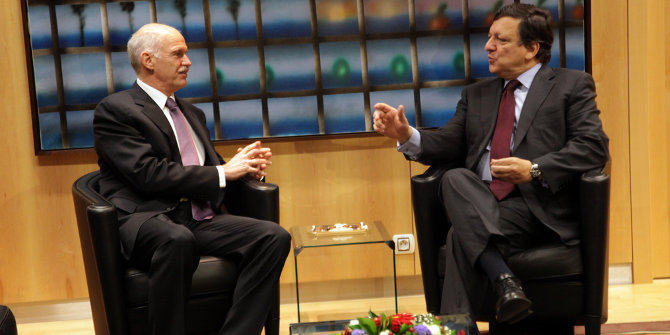In 2018, the European Commission rejected a draft budget by the Italian government on the grounds that it was incompatible with EU rules. Drawing on a new study, Gemma Gasseau and Vincenzo Maccarrone show what this affair can tell us about the influence of business interests on national budgets.
Following the outbreak of the COVID-19 pandemic, the EU’s Stability and Growth Pact rules were effectively suspended and EU member states enjoyed more freedom in the running of their national finances.
However, EU fiscal constraints are due to make a return and even if the rules have been reformed, they will still have a significant impact on national budgets, putting pressure on states like Italy to tackle their public debt. In turn, this is likely to create significant tensions between national and European executives, as we have seen on many occasions in the past.
Italy’s 2018 budget negotiations
In a recent study, we analyse one infamous example of these tensions: negotiations in 2018 between the European Commission and the Italian government over Italy’s budget. These negotiations received both media and scholarly attention for at least two main reasons.
First, Italy’s government, led by the Five Star Movement and the League, was the first self-styled “populist” alliance to govern a large EU country. Second, during the negotiations, the European Commission for the first time rejected a draft budgetary plan from one of its member states. It did so by using new powers it had gained following the eurozone crisis and the establishment of a new European economic governance regime.
We use a critical political economy approach by focusing on the role played by competing business interests in shaping Italy’s budget policy. Historically, the main division within Italian capitalism has been between “large enterprises” and “small and medium enterprises”. We thus assess separately the interests of these two groups of actors in the process of budget formation and we analyse whether diverging positions emerged.
To review the events surrounding the budget negotiations, we use documents produced by the actors involved. These include documents by the Italian Ministry of Economy and Finance, the Italian Presidency of the Council of Ministers and the European Commission. We also use a large number of newspaper articles, mostly from Ilsole24ore, the most authoritative newspaper in Italy for news on economic and financial affairs.
Finally, we analyse the stances of enterprises on the draft budgetary plan through a qualitative content analysis of the documents (press releases and parliamentary hearings) that they produced on the matter. This allows us to assess if requests from employers’ associations were fulfilled by the government in the economic and fiscal policies included in the budget.
The mobilisation of capital
Our analysis shows diverging preferences on the budget between large enterprises, on the one hand, and small and medium enterprises on the other. We also find that the stances of small and medium enterprises influenced most of the content of the budget. This happened because both the Five Star Movement and the League sought to embed small and medium enterprises within their electoral bloc.
However, large enterprises played a key role in pushing for a compromise between the national and European executives on the total amount of the 2019 deficit, which was in the end lowered (from 2.4% to 2.04%) avoiding a full confrontation with the EU. This was also an acceptable compromise for the European Commission, as it avoided a clash with the government of one of the largest EU member states just a few months before the 2019 European Parliament elections.
We find that a key moment in the negotiations was the mobilisation of capital around a question seemingly unrelated to the draft budgetary plan: the construction of a high-speed rail line between Turin and Lyon. This was an issue on which the two coalition parties had opposing views, with the Five Star Movement being opposed and the League in favour. Large enterprises leveraged their structural power to influence the government on the issue, but also on its broader budgetary policies.
The main organisation representing the interests of large enterprises – Confindustria – initially mobilised businesses around the Turin-Lyon rail link and soon managed to bring together 15 business associations, representing a huge share of Italian business interests. Confindustria connected the issue of the rail link to broader questions, such as the government’s stance on large investment projects and the need to avoid a clash with the EU over the country’s budget.
In doing so, Confindustria succeeded in building a historic bloc of business interests around the rail link, which came to represent the wider goals of improving infrastructure and generating growth. This unification of Italian capital also illustrated the fragility of the alliance between the Five Star Movement and the League, which subsequently collapsed when a Five Star Movement motion to stop the rail link failed to get enough support.
Enduring contradictions
The 2018 Italian budget negotiations also tell us something important about the nature of populism within Italian politics. Both the Five Star Movement and the League were regarded as populist parties, yet their populism did not lie in a critique of EU rules, which they eventually accepted, but rather in their attempt to present both workers and businesses as “victims of globalisation”. They used this narrative to mobilise support against the European economic governance regime from the perspective of the Italian nation, rather than from a class-based perspective.
This focus on national sovereignty portrayed the EU in purely institutional terms, ignoring its social purpose. However, the compromise between the Italian government and the Commission led to the two most significant social policy measures contained in the budget being significantly curtailed. The social dimension thus clearly emerged through the outcome of the negotiations.
In 2021, just three years after their open challenge to the European Commission, both the Five Star Movement and the League backed a “grand coalition” that brought the former President of the European Central Bank, Mario Draghi, to power at the head of a technocratic government. Draghi’s rise to power and the subsequent victory by a conservative coalition led by Giorgia Meloni’s Brothers of Italy in the 2022 Italian general election highlight the contradictions inherent in the trajectory of Italian political economy. Our analysis shows that critical political economy perspectives have the potential to help illuminate these trends.
For more information, see the authors’ accompanying paper at Global Political Economy
Note: This article gives the views of the authors, not the position of EUROPP – European Politics and Policy or the London School of Economics. Featured image credit: European Union





